Lexus IS220d 2012 Owner's Manual
Manufacturer: LEXUS, Model Year: 2012, Model line: IS220d, Model: Lexus IS220d 2012Pages: 609, PDF Size: 14.63 MB
Page 251 of 609
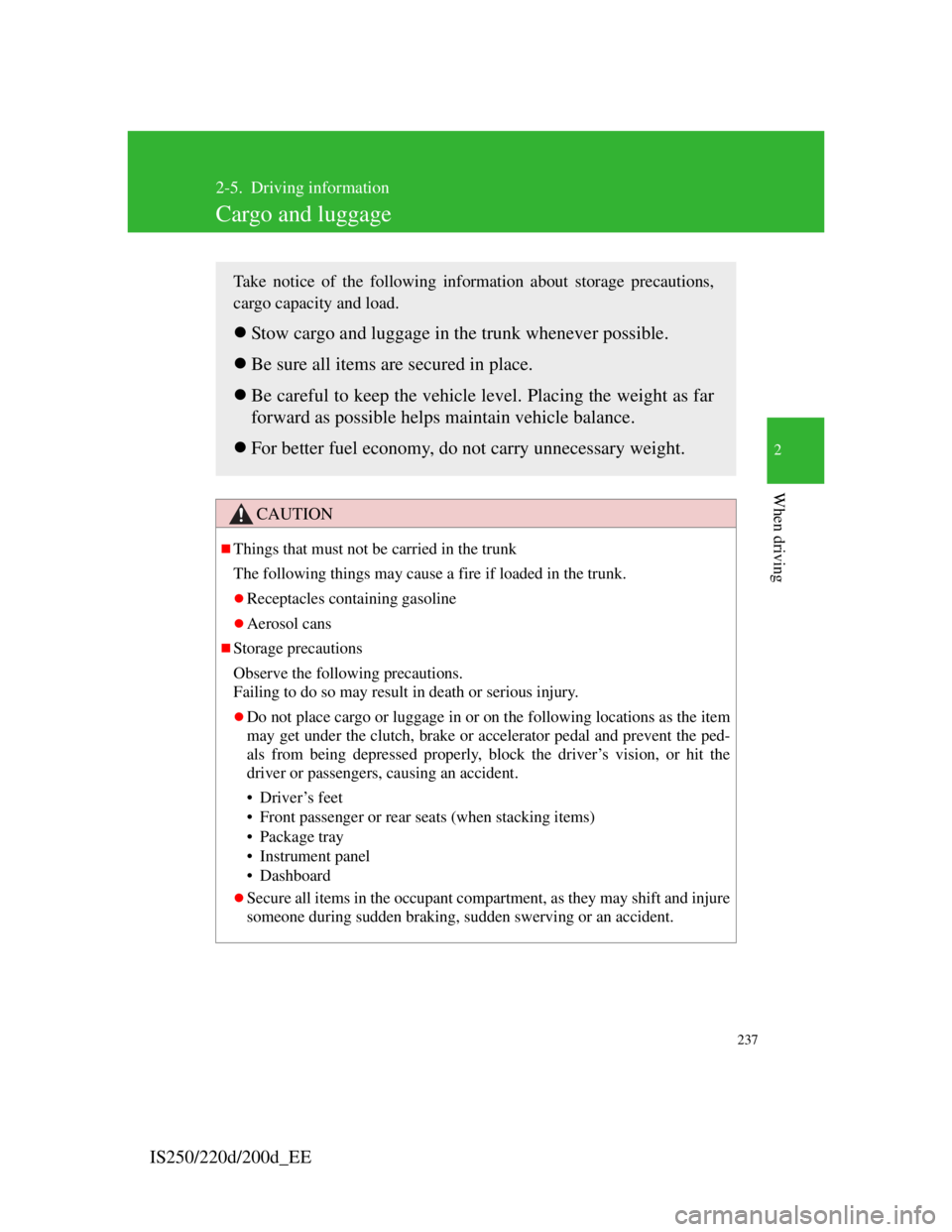
237
2
When driving
IS250/220d/200d_EE
2-5. Driving information
Cargo and luggage
CAUTION
Things that must not be carried in the trunk
The following things may cause a fire if loaded in the trunk.
Receptacles containing gasoline
Aerosol cans
Storage precautions
Observe the following precautions.
Failing to do so may result in death or serious injury.
Do not place cargo or luggage in or on the following locations as the item
may get under the clutch, brake or accelerator pedal and prevent the ped-
als from being depressed properly, block the driver’s vision, or hit the
driver or passengers, causing an accident.
• Driver’s feet
• Front passenger or rear seats (when stacking items)
• Package tray
• Instrument panel
• Dashboard
Secure all items in the occupant compartment, as they may shift and injure
someone during sudden braking, sudden swerving or an accident.
Take notice of the following information about storage precautions,
cargo capacity and load.
Stow cargo and luggage in the trunk whenever possible.
Be sure all items are secured in place.
Be careful to keep the vehicle level. Placing the weight as far
forward as possible helps maintain vehicle balance.
For better fuel economy, do not carry unnecessary weight.
Page 252 of 609

238
2-5. Driving information
IS250/220d/200d_EE
CAUTION
Luggage capacity and distribution
Observe the following precautions. Failure to do so will not only put load on
the tires, but also reduce steering and braking performance. This could lead
to an accident resulting in serious injury or even death.
Do not overload the vehicle.
Do not apply load to the vehicle unevenly.
Page 253 of 609
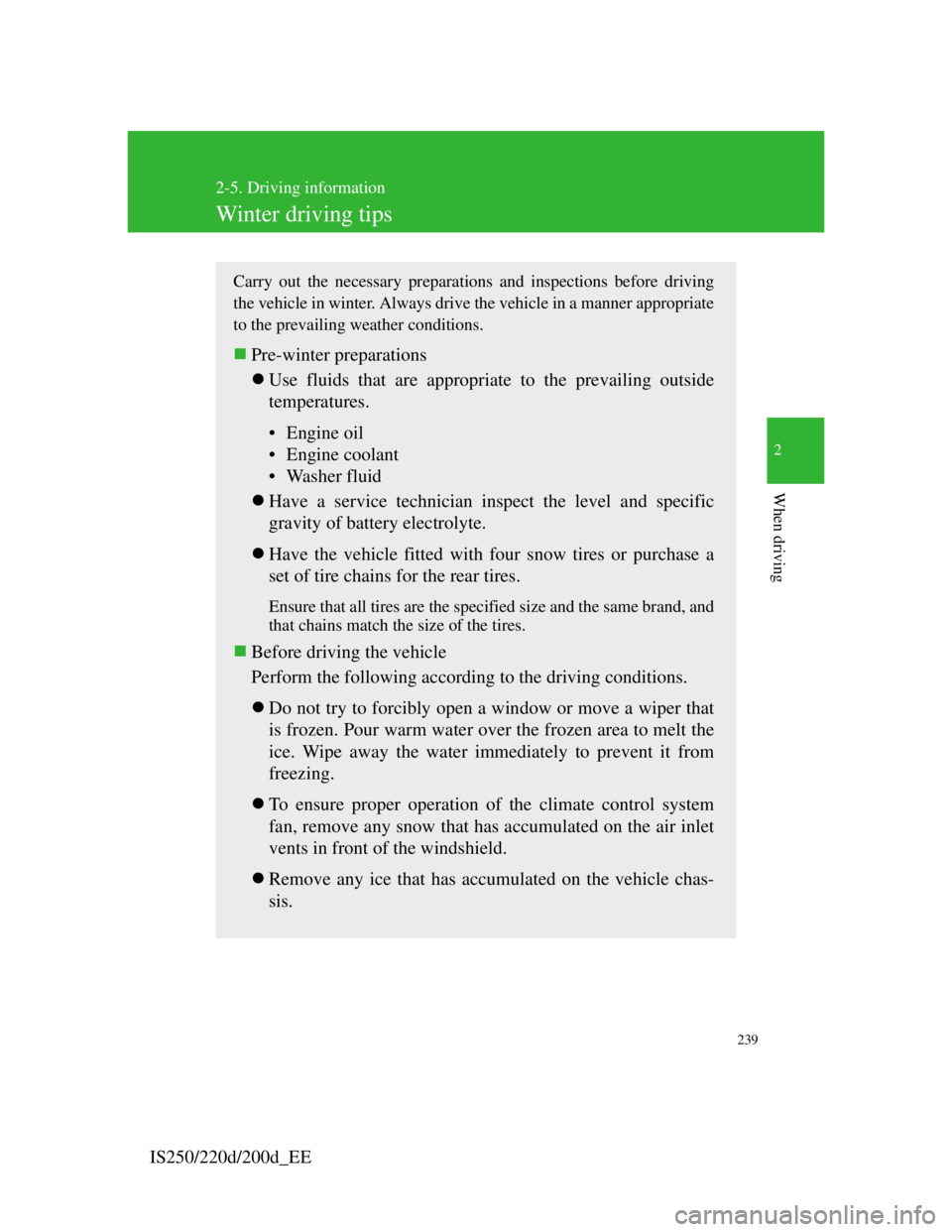
239
2-5. Driving information
2
When driving
IS250/220d/200d_EE
Winter driving tips
Carry out the necessary preparations and inspections before driving
the vehicle in winter. Always drive the vehicle in a manner appropriate
to the prevailing weather conditions.
Pre-winter preparations
Use fluids that are appropriate to the prevailing outside
temperatures.
• Engine oil
• Engine coolant
• Washer fluid
Have a service technician inspect the level and specific
gravity of battery electrolyte.
Have the vehicle fitted with four snow tires or purchase a
set of tire chains for the rear tires.
Ensure that all tires are the specified size and the same brand, and
that chains match the size of the tires.
Before driving the vehicle
Perform the following according to the driving conditions.
Do not try to forcibly open a window or move a wiper that
is frozen. Pour warm water over the frozen area to melt the
ice. Wipe away the water immediately to prevent it from
freezing.
To ensure proper operation of the climate control system
fan, remove any snow that has accumulated on the air inlet
vents in front of the windshield.
Remove any ice that has accumulated on the vehicle chas-
sis.
Page 254 of 609
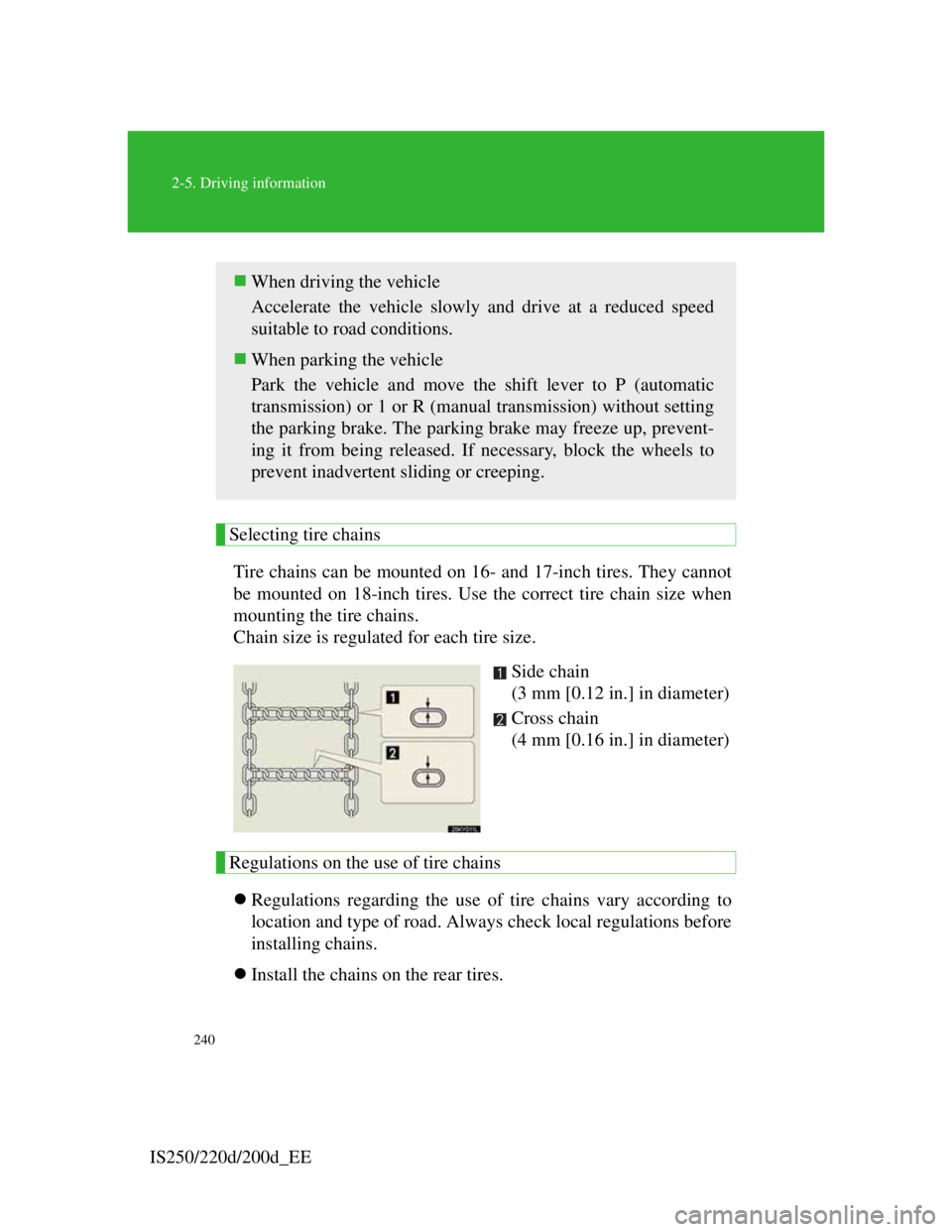
240
2-5. Driving information
IS250/220d/200d_EE
Selecting tire chains
Tire chains can be mounted on 16- and 17-inch tires. They cannot
be mounted on 18-inch tires. Use the correct tire chain size when
mounting the tire chains.
Chain size is regulated for each tire size.
Side chain
(3 mm [0.12 in.] in diameter)
Cross chain
(4 mm [0.16 in.] in diameter)
Regulations on the use of tire chains
Regulations regarding the use of tire chains vary according to
location and type of road. Always check local regulations before
installing chains.
Install the chains on the rear tires.
When driving the vehicle
Accelerate the vehicle slowly and drive at a reduced speed
suitable to road conditions.
When parking the vehicle
Park the vehicle and move the shift lever to P (automatic
transmission) or 1 or R (manual transmission) without setting
the parking brake. The parking brake may freeze up, prevent-
ing it from being released. If necessary, block the wheels to
prevent inadvertent sliding or creeping.
Page 255 of 609
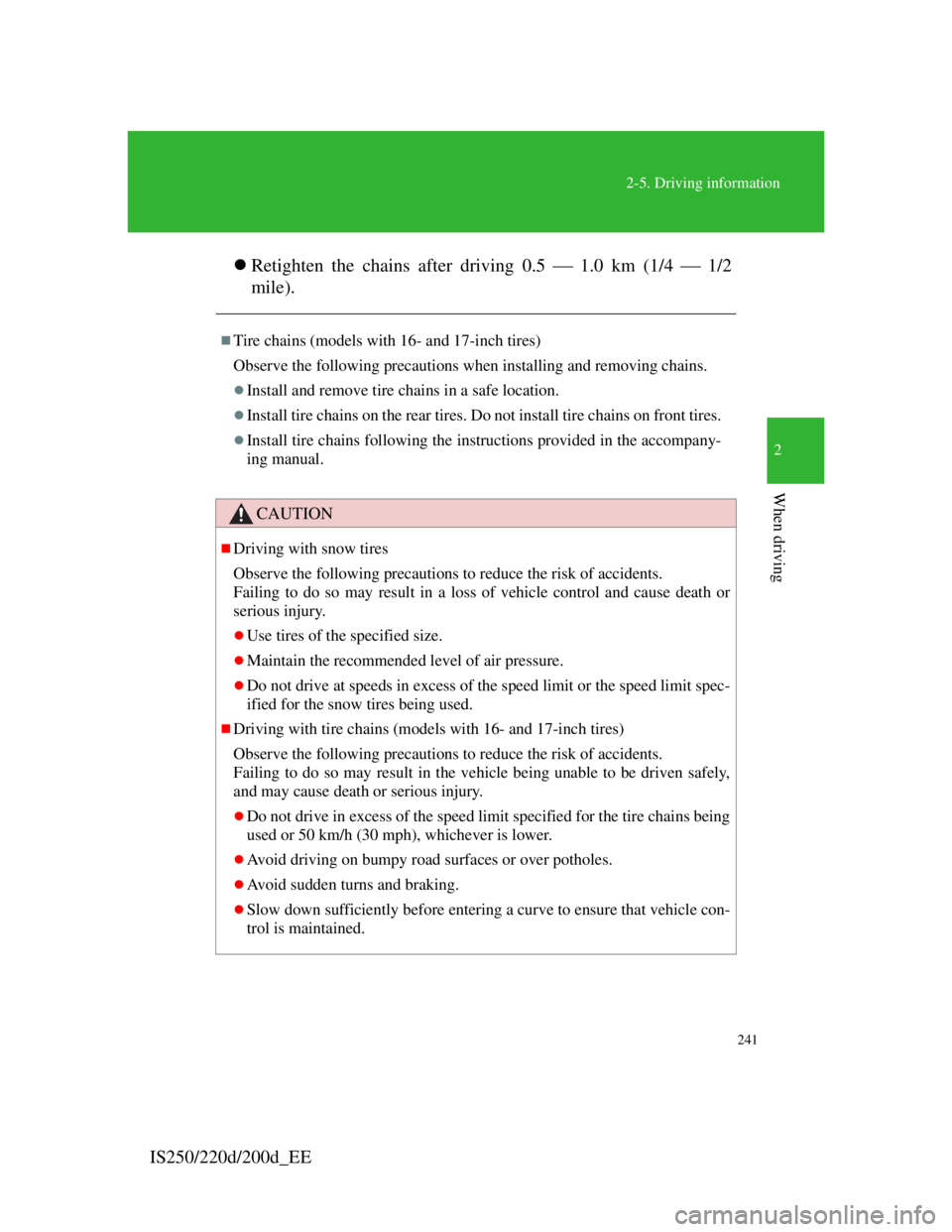
241
2-5. Driving information
2
When driving
IS250/220d/200d_EERetighten the chains after driving 0.5 1.0 km (1/4 1/2
mile).
Tire chains (models with 16- and 17-inch tires)
Observe the following precautions when installing and removing chains.
Install and remove tire chains in a safe location.
Install tire chains on the rear tires. Do not install tire chains on front tires.
Install tire chains following the instructions provided in the accompany-
ing manual.
CAUTION
Driving with snow tires
Observe the following precautions to reduce the risk of accidents.
Failing to do so may result in a loss of vehicle control and cause death or
serious injury.
Use tires of the specified size.
Maintain the recommended level of air pressure.
Do not drive at speeds in excess of the speed limit or the speed limit spec-
ified for the snow tires being used.
Driving with tire chains (models with 16- and 17-inch tires)
Observe the following precautions to reduce the risk of accidents.
Failing to do so may result in the vehicle being unable to be driven safely,
and may cause death or serious injury.
Do not drive in excess of the speed limit specified for the tire chains being
used or 50 km/h (30 mph), whichever is lower.
Avoid driving on bumpy road surfaces or over potholes.
Avoid sudden turns and braking.
Slow down sufficiently before entering a curve to ensure that vehicle con-
trol is maintained.
Page 256 of 609
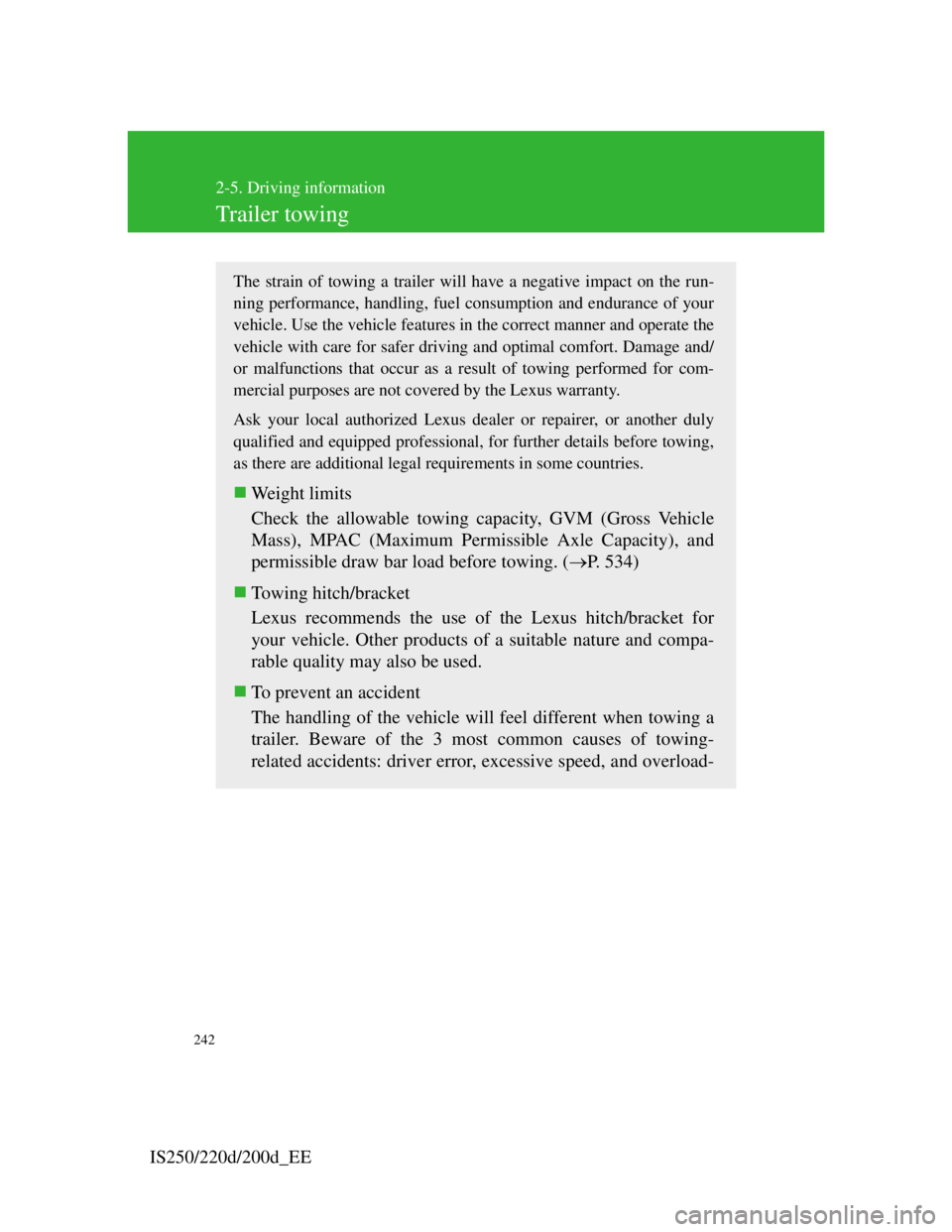
242
2-5. Driving information
IS250/220d/200d_EE
Trailer towing
The strain of towing a trailer will have a negative impact on the run-
ning performance, handling, fuel consumption and endurance of your
vehicle. Use the vehicle features in the correct manner and operate the
vehicle with care for safer driving and optimal comfort. Damage and/
or malfunctions that occur as a result of towing performed for com-
mercial purposes are not covered by the Lexus warranty.
Ask your local authorized Lexus dealer or repairer, or another duly
qualified and equipped professional, for further details before towing,
as there are additional legal requirements in some countries.
Weight limits
Check the allowable towing capacity, GVM (Gross Vehicle
Mass), MPAC (Maximum Permissible Axle Capacity), and
permissible draw bar load before towing. (P. 534)
Towing hitch/bracket
Lexus recommends the use of the Lexus hitch/bracket for
your vehicle. Other products of a suitable nature and compa-
rable quality may also be used.
To prevent an accident
The handling of the vehicle will feel different when towing a
trailer. Beware of the 3 most common causes of towing-
related accidents: driver error, excessive speed, and overload-
Page 257 of 609
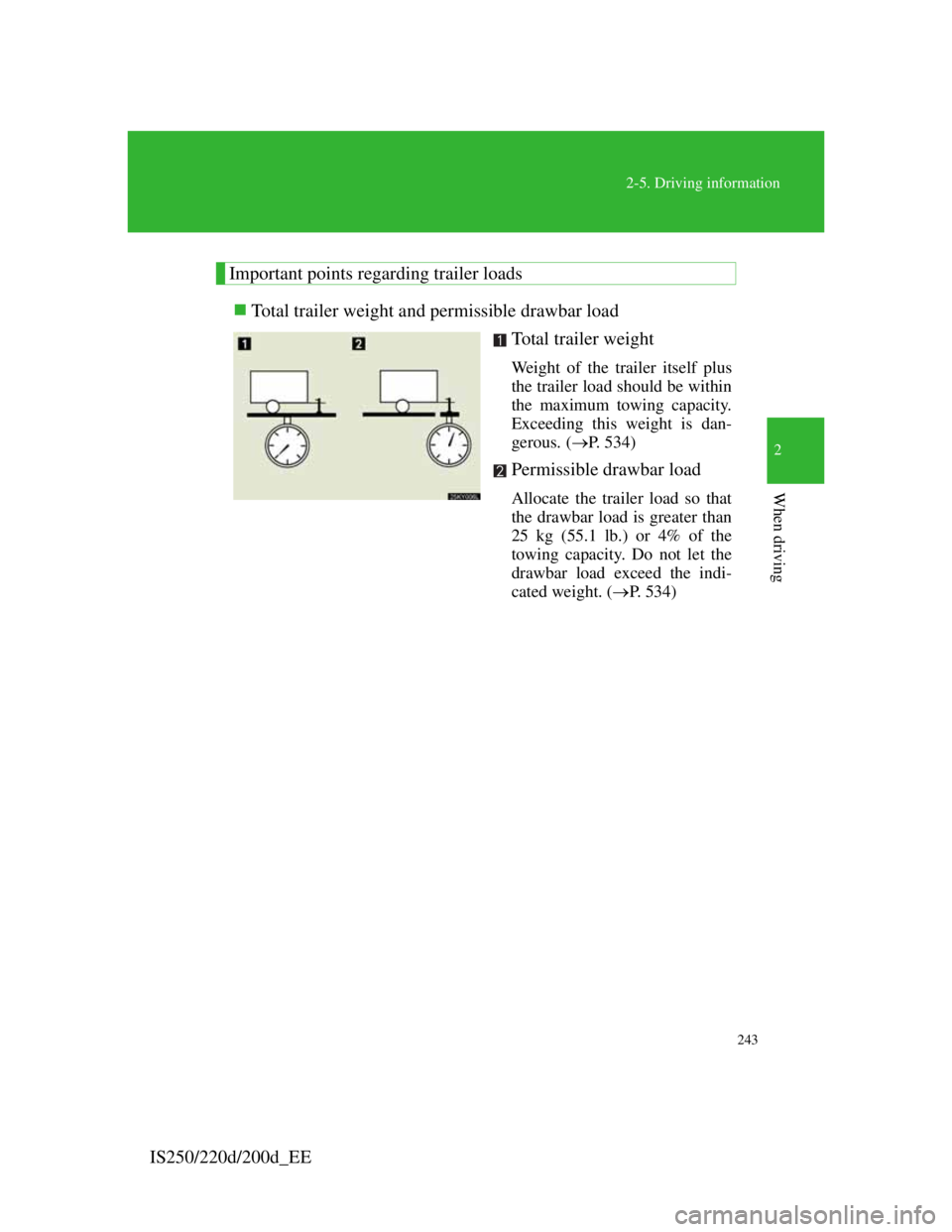
243
2-5. Driving information
2
When driving
IS250/220d/200d_EE
Important points regarding trailer loads
Total trailer weight and permissible drawbar load
Total trailer weight
Weight of the trailer itself plus
the trailer load should be within
the maximum towing capacity.
Exceeding this weight is dan-
gerous.
(P. 534)
Permissible drawbar load
Allocate the trailer load so that
the drawbar load is greater than
25 kg (55.1 lb.) or 4% of the
towing capacity. Do not let the
drawbar load exceed the indi-
cated weight. (P. 534)
Page 258 of 609
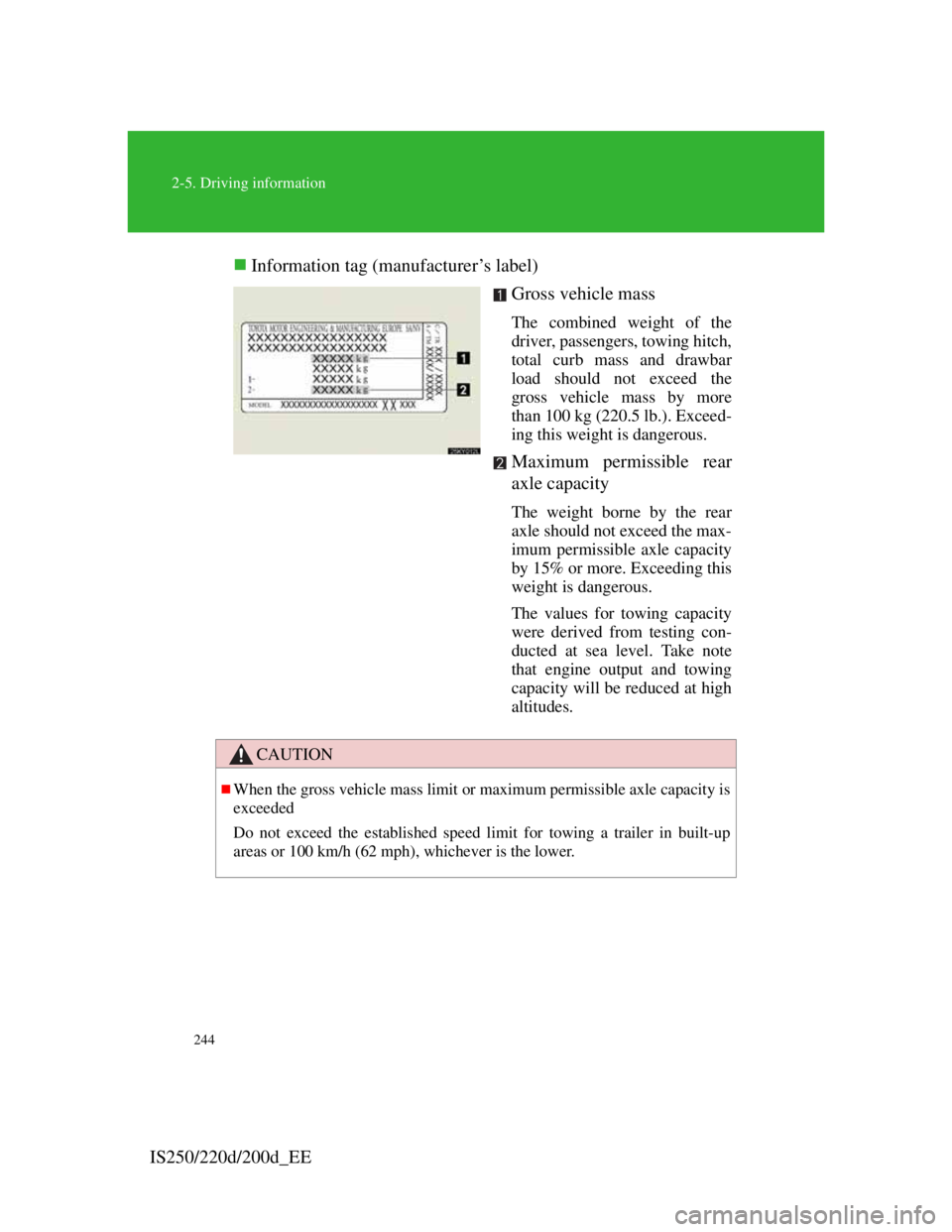
244
2-5. Driving information
IS250/220d/200d_EEInformation tag (manufacturer’s label)
Gross vehicle mass
The combined weight of the
driver, passengers, towing hitch,
total curb mass and drawbar
load should not exceed the
gross vehicle mass by more
than 100 kg (220.5 lb.). Exceed-
ing this weight is dangerous.
Maximum permissible rear
axle capacity
The weight borne by the rear
axle should not exceed the max-
imum permissible axle capacity
by 15% or more. Exceeding this
weight is dangerous.
The values for towing capacity
were derived from testing con-
ducted at sea level. Take note
that engine output and towing
capacity will be reduced at high
altitudes.
CAUTION
When the gross vehicle mass limit or maximum permissible axle capacity is
exceeded
Do not exceed the established speed limit for towing a trailer in built-up
areas or 100 km/h (62 mph), whichever is the lower.
Page 259 of 609
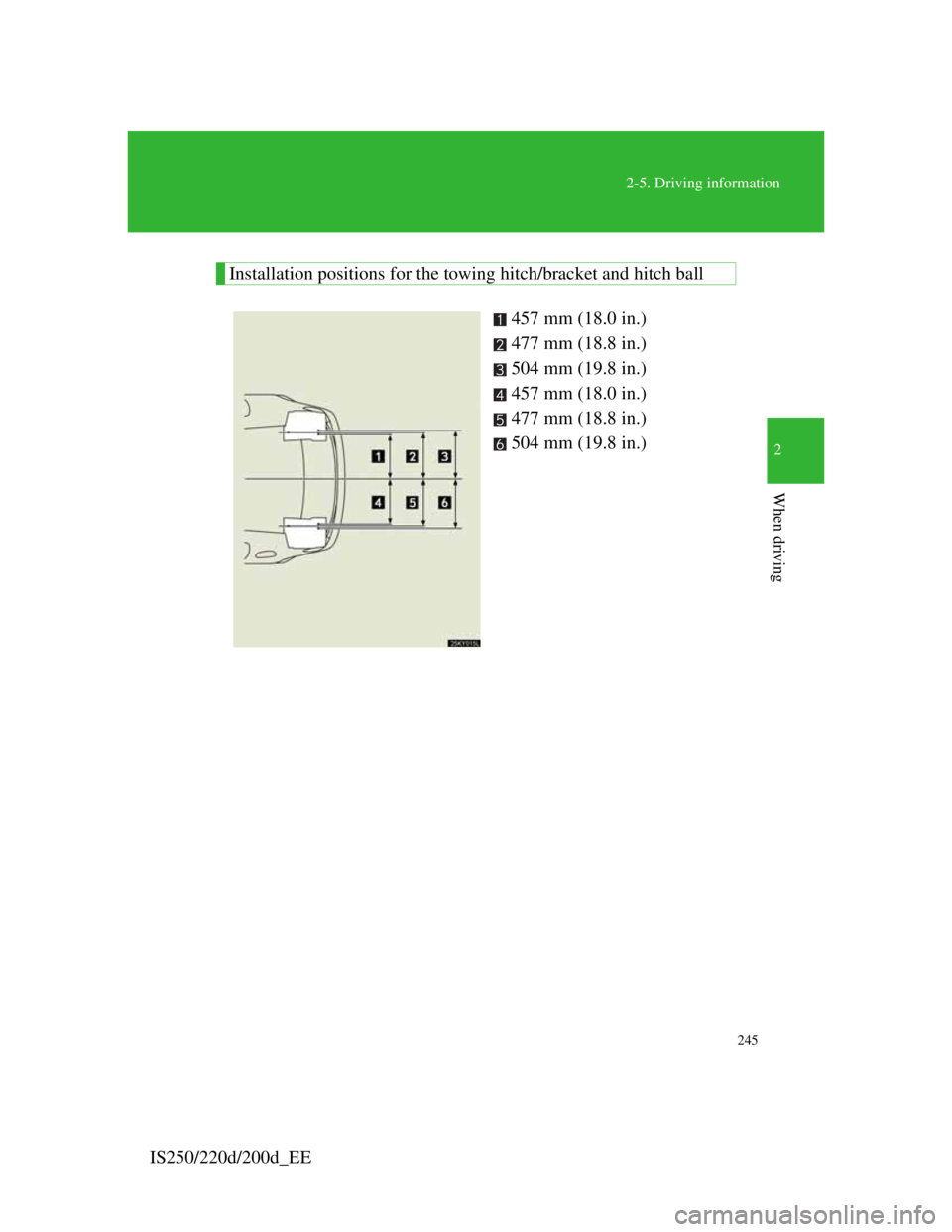
245
2-5. Driving information
2
When driving
IS250/220d/200d_EE
Installation positions for the towing hitch/bracket and hitch ball
457 mm (18.0 in.)
477 mm (18.8 in.)
504 mm (19.8 in.)
457 mm (18.0 in.)
477 mm (18.8 in.)
504 mm (19.8 in.)
Page 260 of 609
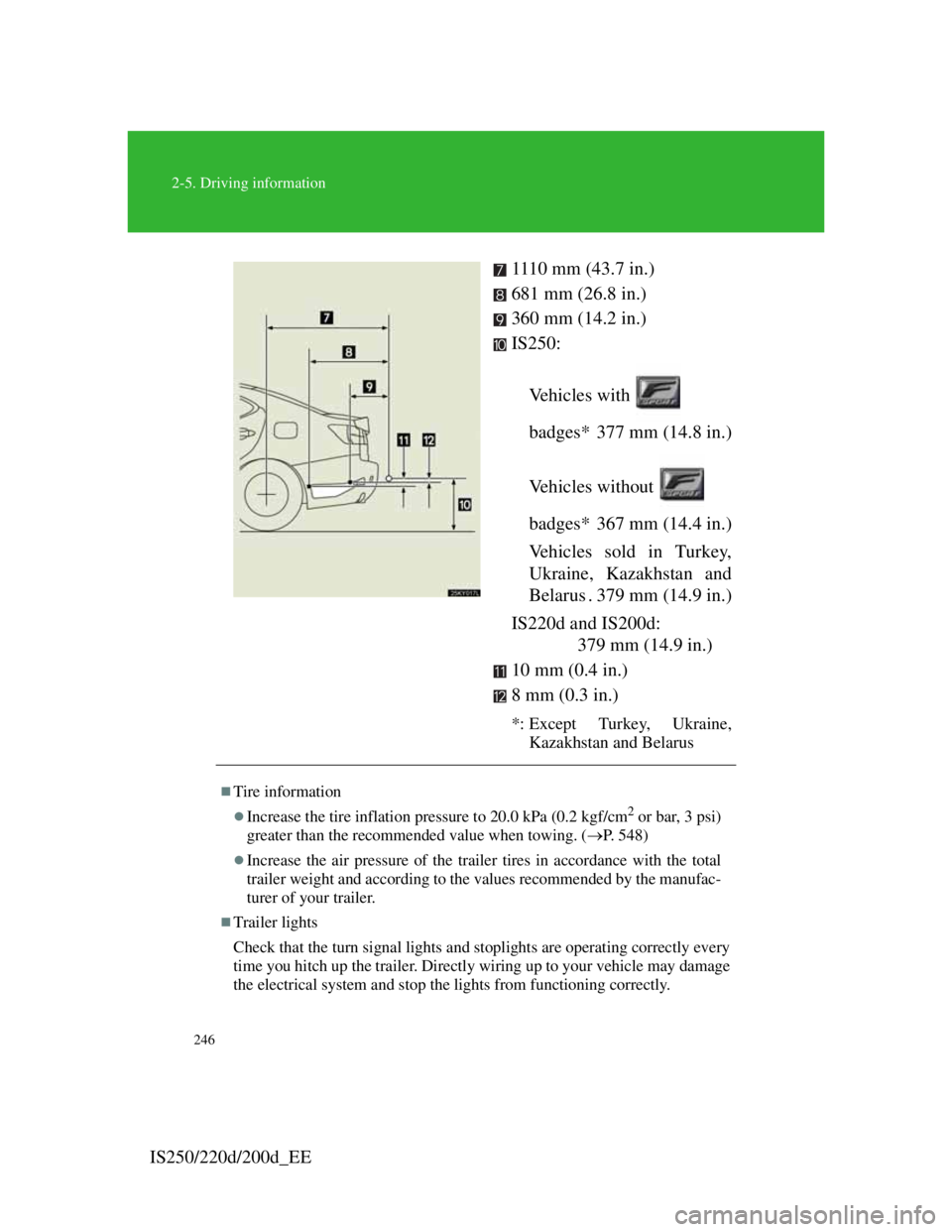
246
2-5. Driving information
IS250/220d/200d_EE1110 mm (43.7 in.)
681 mm (26.8 in.)
360 mm (14.2 in.)
IS250:
Vehicles with
badges* 377 mm (14.8 in.)
Vehicles without
badges* 367 mm (14.4 in.)
Vehicles sold in Turkey,
Ukraine, Kazakhstan and
Belarus . 379 mm (14.9 in.)
IS220d and IS200d:
379 mm (14.9 in.)
10 mm (0.4 in.)
8 mm (0.3 in.)
*: Except Turkey, Ukraine,
Kazakhstan and Belarus
Tire information
Increase the tire inflation pressure to 20.0 kPa (0.2 kgf/cm2 or bar, 3 psi)
greater than the recommended value when towing. (P. 548)
Increase the air pressure of the trailer tires in accordance with the total
trailer weight and according to the values recommended by the manufac-
turer of your trailer.
Trailer lights
Check that the turn signal lights and stoplights are operating correctly every
time you hitch up the trailer. Directly wiring up to your vehicle may damage
the electrical system and stop the lights from functioning correctly.